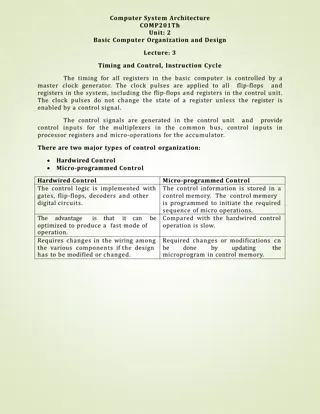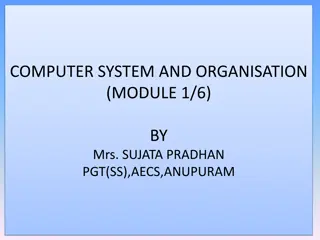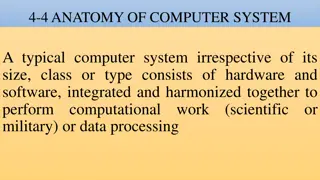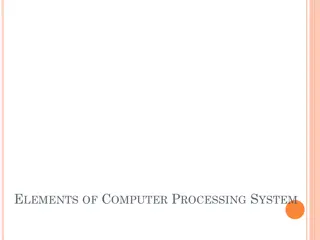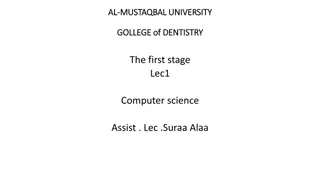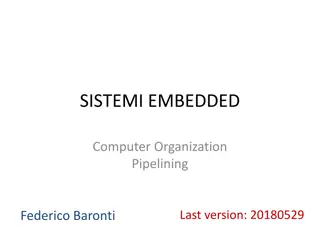Computer Organization
The importance of stack in recursive function calls for tracking values within argument registers and saved registers. Follow the journey of function calls with stack pointer illustrations and memory frames. See how the stack grows and stores return addresses and argument values for efficient recursion.
Download Presentation

Please find below an Image/Link to download the presentation.
The content on the website is provided AS IS for your information and personal use only. It may not be sold, licensed, or shared on other websites without obtaining consent from the author.If you encounter any issues during the download, it is possible that the publisher has removed the file from their server.
You are allowed to download the files provided on this website for personal or commercial use, subject to the condition that they are used lawfully. All files are the property of their respective owners.
The content on the website is provided AS IS for your information and personal use only. It may not be sold, licensed, or shared on other websites without obtaining consent from the author.
E N D
Presentation Transcript
Computer Organization CS345 David Monismith Based upon notes by Dr. Bill Siever and notes from the Patternson and Hennessy Text
Review Continued review of Power example and using the stack
Stack Pointer Notice that the stack is important for use in nested function calls. Since recursive functions include many nested function calls, the stack is essential for recursion. We need the stack so we can keep track of the values within argument registers, and saved registers each time we make a function call. Let's see what happens when we call power(4, 3). Assume that this function takes 4 to the third power and uses recursion rather than a loop to compute the result. The result should be 64. The first call to this function is power(4,3) and we will assume that this call comes from the main function. We need to store the return address and the power (the second argument) on the stack. We don't necessarily need to store the value four anywhere other than an argument register because it will stay the same on every call we make. If we look at the code on the examples page, we see that on our first call, we store the return address in the current function's frame, and we store the argument register in the calling function's frame.
+--------------------+ <---- $sp (frame for first call) | | empty +--------------------+ | | empty <---- $sp + 4 +--------------------+ | | empty <---- $sp + 8 +--------------------+ | | empty <---- $sp + 12 +--------------------+ | | empty <---- $sp + 16 +--------------------+ | ret. addr. for main| ra <---- $sp + 20 +--------------------+ <---- main function frame | $a1 = 3 | empty <---- $sp + 24 +--------------------+ | | empty +--------------------+ | | empty +--------------------+ | | empty +--------------------+ | | empty +--------------------+ | | empty +--------------------+ <---- End of memory Stack Pointer Notice that the return address is stored in the frame for power(4,3) and the argument value for the power (3) is stored in the calling function's frame. That is we store 3 in the frame for the main function.
+--------------------+ <---- $sp (frame for second call) | | empty +--------------------+ | | empty <---- $sp + 4 +--------------------+ | | empty <---- $sp + 8 +--------------------+ | | empty <---- $sp + 12 +--------------------+ | | empty <---- $sp + 16 +--------------------+ | ret. To pow(4,3) | ra <---- $sp + 20 +--------------------+ <---- (frame for first call) | $a1 = 2 | empty <---- $sp + 24 +--------------------+ | | empty <---- $sp + 28 +--------------------+ | | empty <---- $sp + 32 +--------------------+ | | empty <---- $sp + 36 +--------------------+ | | empty <---- $sp + 40 +--------------------+ |ret. addr. for main| ra <---- $sp + 44 +--------------------+ <---- main function frame | $a1 = 3 | empty <---- $sp + 48 +--------------------+ | | empty +--------------------+ | | empty +--------------------+ <---- End of memory Stack Pointer On the second call power(4,2), notice that the stack grows and the return address to the call from power(4,3) is stored in the current stack frame, and the current value of the argument register is stored in the previous frame.
Stack Pointer On the third call power(4,1), notice that the stack grows and the return address to the call from power(4,2) is stored in the current stack frame, and the current value of the argument register is stored in the previous frame.
Stack Pointer Once we reach the last call notice that all the data needed to return from each function is provided. In the last call we simply return the value of the first argument register ($a0). That is, we return four. This value is stored in the return register ($v0). Additionally we pop the stack. Now $v0 is 4 and the stack looks as follows:
Stack Pointer As we return from the second call of power(4,2), we multiply $v0 by $a0 or four and store the result in $v0. So now $v0 is 16, and we can pop the stack again. Remember that we have to update the $ra register to return to the proper location.
Stack Pointer Finally, we will return from the call power(4,3). Again we must multiply $v0 by $a0. Recall that $v0 is 16 and $a0 is 4. So the result stored in $v0 is 64. We also need to load the return address for the main function from the stack into $ra so we can return to main. +----------------------+ <---- main function frame | $a1 = 3 | empty <---- $sp +----------------------+ | | empty +----------------------+ | | empty +----------------------+ | | empty +----------------------+ | | empty +----------------------+ | | empty +----------------------+ <---- End of memory
Stack Pointer Once we return to the main method, the result of power(4,3) will be stored in $v0, and after returning, we may pop the stack so that all the memory utilized will be available for future use. In the event we need more space for arguments, we can simply allocate more space for each activation record and utilize memory to pass arguments to functions





